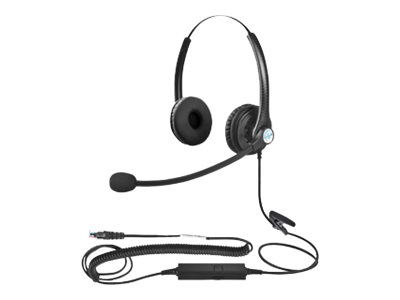
A detailed list of technical data, specifications, ratings and expert review of JLC Flux. Get a comprehensive look at your chosen headphones and see if these are the ones that will best suit your needs. You can also use the comparison feature to compare with other competing headphones.
design and dimensions sound quality microphone connections others
| DESIGN AND DIMENSIONS JLC Flux |
|---|
| Product Type | Headset - wired - RJ-11 | |
|---|---|---|
| Recommended Use | Communication |
The JLC Flux are wired headphones. In the case of studio and professional DJ headphones, a wired connection is a standard and a necessity. In this case, connecting via cable reduces audio transmission delays and prevents unwanted battery drain as it would be in case of wireless headphones. The same is de facto true for gaming headsets. In case of headphones for normal music listening, the cable is rather a relic, although it still has its fans. However, the wireless option is much more popular for everyday use in today’s world.
The headphones are designed as on-ear. On-ear headphones are generally lighter. However, their design has fewer isolation capabilities, and therefore, for example, more sound can be let in and out compared to around-ear headphones.
| SOUND QUALITY JLC Flux |
|---|
| Headphones Form Factor | On-ear | |
|---|---|---|
| Adjustable Headband | Yes | |
| Connectivity Technology | Wired | |
| Sound Output Mode | Stereo | |
| Frequency Response | 150 - 4500 Hz | Worse than 97 % of headphones rated. |
| Max Input Power | 50 mW |
The sound quality can be affected by many factors. For many users the frequency range is a key feature of headphones. The wider the range, the more detail and nuance you will hear while listening. However, every individual perceives frequencies differently, so the frequency range of headphones varies according to individual needs. The average person perceives frequencies in the range of 16 to 20,000 Hz, so headphones with a frequency range of 20 to 20,000 Hz are most commonly available. If you are looking for headphones with a good bass performance, you should aim for lower range values (bass represents frequencies up to about 256 Hz), while high range values (frequencies roughly above 2,048 Hz) will be better for reproducing high tones. The frequency range of headphones JLC Flux is 150 - 4500 Hz. The maximum input power of these headphones indicates how many decibels they can receive from the device without any damage. For JLC Flux, it is 50 mW.
Show more| MICROPHONE JLC Flux |
|---|
| Form Factor | Headset microphone | |
|---|---|---|
| Type | Boom | |
| Frequency Response | 50 - 3000 Hz | Worse than 99 % of headphones rated. |
| Sensitivity | -44 dB | |
| Sensitivity Margin | +/- 3dB | |
| Impedance | 2.2 kOhm |
JLC Flux has a boom–type microphone. The microphone sensitivity is -44 dB. A lower microphone sensitivity will generally ensure that even quieter sounds are caught. On the other hand, in noisier environments, distortion of the recording may occur. With a higher sensitivity, the microphone will not distort the recording even in noisy environments. On the other hand, the microphone will not pick up quieter sounds. So it depends on the environment and the purposes you plan to use the headphones for.
Show more| CONNECTIONS JLC Flux |
|---|
| Connector Type | Headset (RJ-11) |
|---|
| OTHERS JLC Flux |
|---|
| Compatibility | Linux, Mac, Windows | |
|---|---|---|
| Compatible Software | Microsoft Teams, Zoom, Skype |
Similar Headphones
Other JLC Headphones